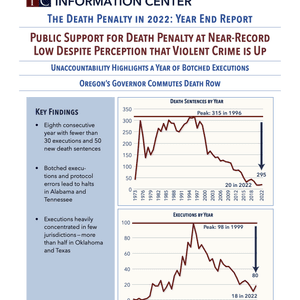
The American Bar Association’s Criminal Justice Section has released The State of Criminal Justice 2020, its annual report on issues, trends, and significant changes in America’s criminal justice system. The ABA book includes a chapter on significant capital punishment developments over the past year, authored by Ronald J. Tabak, chair of the Death Penalty Committee of the ABA’s Section of Civil Rights and Social Justice. Tabak’s analysis highlights the continuing long-term downward trend in death sentences and executions; geographic, racial, and economic factors that, he says, contribute to its arbitrary application; and the decrease in public support for its use.
Tabak writes that “2019 was the fifth straight year with fewer than 30 executions” and fewer than fifty new death sentences. He notes that death penalty usage continues to be geographically concentrated within a small number of jurisdictions. “[J]ust seven states accounted for all of the country’s executions,” Tabak reports. Similarly, half of the 34 new death sentences were imposed in just three states and fewer than 1% of U.S. counties accounted for all the new death sentences imposed across the nation.
The decline in death-penalty usage was not accompanied by progress alleviating systemic unfairness, Tabak wrote. Even as the annual number of executions in the United States remained near a three-decade low point and death sentences stayed near 40-year lows, Tabak found that “there are significant questions about the guilt of a growing percentage of the death row prisoners who are executed or whose execution dates are in the near future.”
Tabak — who is a longtime member of the Steering Committee of the ABA’s Death Penalty Representation Project — attributed part of the decline in new death sentences to the increasing number of states abolishing the death penalty or placing moratoriums on executions. In the past year, two states (New Hampshire and Colorado) abolished the death penalty, the state with the nation’s largest death-row (California) placed a formal moratorium on executions, and another state (Ohio) placed a de facto moratorium on executions.
Despite the decline, Tabak said a multitude of important death-penalty issues remain, including the continuing execution of prisoners with histories of severe mental illness, the use of forensic evidence lacking in scientific validity, death sentences resulting from ineffectiveness representation or from courts permitting questionable waivers of the right to counsel, and the expansion of procedural “traps” that prevent courts from reviewing issues and granting relief even when meritorious constitutional errors have been uncovered. Tabak cites a recent Tennessee study that found that “the best predictors of whether the death sentence would be imposed did not include the facts of the crime, but instead were arbitrary factors such as where the murder occurred, the race of the defendant, the quality of the defense, and the views of the prosecutors and judges working on the case.”
Tabak’s capital punishment chapter also discusses major death penalty developments such as the federal government’s plans to resume executions for the first time in 16 years, the life-threatening risks death-row prisoners face from COVID-19 and the pandemic’s disastrous impact on lawyers’ efforts to investigate and present evidence essential to clemency applications, and shifts in public opinion on the death penalty. Public opinion polls in 2019 reported that support for capital punishment remained near record lows and that respondents preferred life without parole over capital punishment when given the option.
Tabak suggests that several factors may be contributing to declining public support for capital punishment, including growing awareness of the link between lynching, racial terrorism, and the death penalty; the public’s growing awareness that innocent people have been sentenced to death and executed; increasing conservative activism against capital punishment; the impact of recent documentaries, books, and movies in shaping cultural attitudes; and the Catholic Church’s updated stance deeming the death penalty “inadmissible.” The chapter also contains a section devoted to major recent court decisions in capital cases.
Tabak ends the chapter with a discussion of the future of capital punishment. He argues that capital punishment in the United States can be justified “only if one believes in arbitrarily and capriciously applied, highly erratic vengeance.” “Ultimately, our society must decide whether to continue with a penalty implemented in ways that cannot survive any serious cost/benefit analysis,” he says. “As more and more people recognize that capital punishment in this country is inconsistent with both conservative and liberal principles, and with common sense, the opportunity for its abolition throughout the United States will arrive. Those who already realize that our actual death penalty is like ‘the emperor’s new clothes’ should do everything with a reasonable chance of accelerating its demise.”
Ronald Tabak, Capital Punishment, The State of Criminal Justice 2020, American Bar Association Criminal Justice Section, June 2020.
Note: Mr. Tabak is a member of the Board of Directors of the Death Penalty Information Center.
Articles
Jun 17, 2024

Research Roundup: Anti-Queer Practices in Capital Cases
Sentencing Data
Jul 01, 2022

